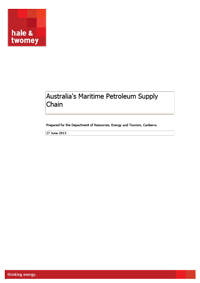Australia's Maritime Petroleum Supply Chain
In 2013, Hale and Twomey was engaged by the Federal Department of Resources, Energy and Tourism (DRET) to examine and report on the maritime supply chain and the key role it plays in Australia's petroleum supply chain.
The report considers how the maritime supply chain operates for Australia and provides a high level summary of all the components in the shipping task from point of loading to discharge (the maritime supply chain). It describes features of the petroleum market where that interacts with the shipping task. The report is intended to inform those interested in understanding the maritime supply chain influences on the security of petroleum supply to Australia.
Some of the key security findings include:
- Australia's supply routes are diverse and are likely to remain that way, even with refinery closures, as more product imports will come from locations other than Singapore.
- Due to the time it takes a ship to travel around Australia, import ships spend a considerable part of their voyage in Australia's EEZ. This results in a large number of tankers close to or within Australia's EEZ and territorial waters at any time.
- While Australia has a lot of import ports, they are typically quite isolated from each other and this makes it difficult to provide land transport back-up from other ports; using shipping to distribute product between ports is a major means of managing local disruption.
- The number of product tankers servicing Australia will increase, even with tankers increasing in size and refineries converted to import terminals receiving larger tankers.
- The import tankers can provide flexibility to respond to domestic supply disruption.
- For the majority of Australia's petroleum imports, the Australian company is likely to own the oil from when it loads (FOB, CFR or CIF purchase). Shipping may still be contracted by the companies' international trading arm or a third party but the cargo owner will hold a documented property interest in the cargo.
- Two scenarios were developed to consider how the shipping market would respond in a supply chain disruption. In reality it is difficult to envisage a scenario in which shipping is not available and historically we cannot point to an event which saw the collapse of the petroleum tanker market.
